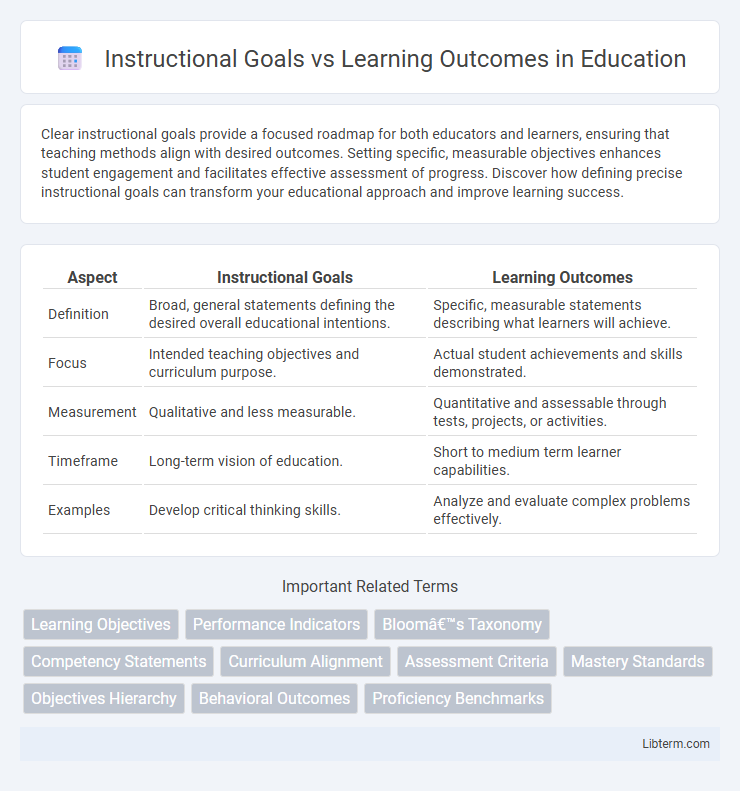Clear instructional goals provide a focused roadmap for both educators and learners, ensuring that teaching methods align with desired outcomes. Setting specific, measurable objectives enhances student engagement and facilitates effective assessment of progress. Discover how defining precise instructional goals can transform your educational approach and improve learning success.
Table of Comparison
| Aspect | Instructional Goals | Learning Outcomes |
|---|---|---|
| Definition | Broad, general statements defining the desired overall educational intentions. | Specific, measurable statements describing what learners will achieve. |
| Focus | Intended teaching objectives and curriculum purpose. | Actual student achievements and skills demonstrated. |
| Measurement | Qualitative and less measurable. | Quantitative and assessable through tests, projects, or activities. |
| Timeframe | Long-term vision of education. | Short to medium term learner capabilities. |
| Examples | Develop critical thinking skills. | Analyze and evaluate complex problems effectively. |
Understanding Instructional Goals
Instructional goals define broad, general intentions of a course or lesson aimed at guiding the overall direction of teaching. They provide educators with a framework to plan curriculum, assessments, and activities aligned with desired skills and knowledge acquisition. Understanding instructional goals helps ensure that learning outcomes are specific, measurable, and directly linked to these overarching educational aspirations.
Defining Learning Outcomes
Learning outcomes clearly define what learners are expected to know, understand, and be able to do after completing a course or module. They are specific, measurable, and learner-centered statements that guide the design of assessments and instructional activities. Unlike broad instructional goals, learning outcomes provide precise criteria for evaluating student performance and mastery of content.
Key Differences Between Instructional Goals and Learning Outcomes
Instructional goals describe broad, general intentions set by educators to guide the teaching process, while learning outcomes specify measurable, concrete skills or knowledge students should acquire. Goals focus on the overall purpose of instruction, often expressed in qualitative terms, whereas learning outcomes emphasize observable and assessable student performance. Understanding this distinction enhances curriculum design and assessment effectiveness by aligning teaching strategies with targeted student achievements.
The Role of Instructional Goals in Curriculum Design
Instructional goals provide a broad framework that guides curriculum design by defining the overall purpose and long-term intentions of educational programs. They establish clear priorities and direction for content selection, instructional strategies, and assessment methods, ensuring alignment throughout the curriculum. By setting these foundational objectives, instructional goals facilitate coherent planning, promote consistency across learning experiences, and support the achievement of specific learning outcomes.
The Importance of Learning Outcomes in Assessment
Learning outcomes play a crucial role in assessment by clearly defining the specific knowledge, skills, and attitudes that students are expected to demonstrate after instruction. Unlike broad instructional goals, learning outcomes provide measurable criteria that enable educators to design effective assessments and evaluate student performance accurately. Precise learning outcomes ensure alignment between teaching methods, assessment tools, and overall educational objectives, leading to improved student achievement and accountability.
Aligning Instructional Goals with Learning Outcomes
Aligning instructional goals with learning outcomes ensures a coherent educational framework that directly links teaching strategies to measurable student achievements. Clear instructional goals provide the foundation for designing assessments that accurately reflect desired learning outcomes, promoting targeted knowledge and skill acquisition. This alignment maximizes instructional effectiveness by creating a consistent path from educational intent to observable student performance.
Common Mistakes in Setting Goals and Outcomes
Common mistakes in setting instructional goals include using vague or overly broad statements that lack measurable criteria, making it difficult to assess student progress effectively. Learning outcomes are often confused with activities or processes rather than focusing on the specific knowledge or skills students should acquire by the end of instruction. Failure to align instructional goals with clearly defined, observable, and achievable learning outcomes can result in misdirected teaching efforts and ineffective assessment strategies.
Best Practices for Writing Learning Outcomes
Effective learning outcomes are clear, measurable, and student-centered, directly aligning with broader instructional goals. Best practices for writing learning outcomes emphasize the use of action verbs from Bloom's Taxonomy to specify observable behaviors, ensuring clarity and assessability. Learning outcomes should focus on what learners will achieve or demonstrate, facilitating targeted instruction and meaningful assessment.
Evaluating the Effectiveness of Instructional Goals and Outcomes
Evaluating the effectiveness of instructional goals involves assessing how clearly the goals guide curriculum design and teaching strategies, ensuring alignment with desired learning outcomes. Measuring learning outcomes focuses on the extent to which students achieve specific skills, knowledge, and attitudes defined by the instructional goals. Data from assessments, feedback, and performance metrics provide evidence to refine both goals and outcomes, enhancing overall instructional quality.
Enhancing Student Achievement Through Clear Goals and Outcomes
Instructional goals provide broad, overarching targets for curriculum design, while learning outcomes specify measurable skills or knowledge students should demonstrate after instruction. Clear articulation of both instructional goals and learning outcomes guides educators in developing focused teaching strategies that improve student engagement and mastery. Emphasizing precise, attainable outcomes aligns assessments with learning objectives, thereby enhancing student achievement through targeted feedback and goal-oriented learning pathways.
Instructional Goals Infographic

 libterm.com
libterm.com